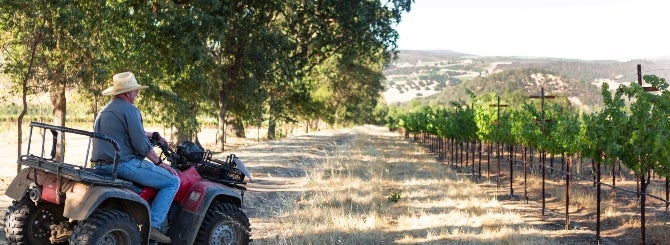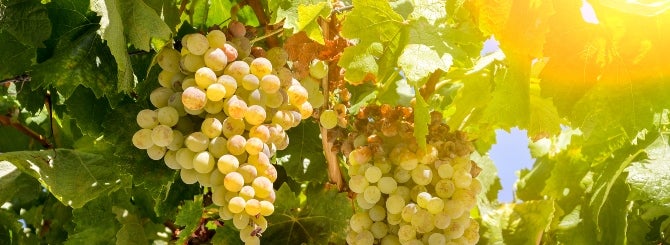
Sauvignon Blanc has been cultivated in Napa Valley for decades, but most wineries have not taken it seriously. For reasons of marketing and not terroir, Chardonnay has been Napa's number one white grape.
That is changing rapidly. Sauvignon Blanc is the trendiest grape variety in the United States. Moreover, Sauvignon Blanc makes sense for Napa viticulturally because it, along with Semillon, is the white grape of Bordeaux, also the source of Cabernet Sauvignon.
| Related stories: |
| Napa's Cold New Reality |
| Napa's Most Expensive Wines |
| The World's Best Sauvignon Blancs |
Napa grapegrower Tom Gamble held a fascinating seminar in September, bringing together five wineries that make Sauvignon Blanc from his vineyard to compare tastes of freshly picked clonal selections of the grapes themselves – which were extremely different from each other – as well as finished wines. For folks who think Sauvignon Blanc is simply a fresh non-Chardonnay quaffer, this would be eye-opening.
The undisputed king of Sauvignon Blanc grapes in Napa Valley is the I-Block of To Kalon Vineyard, planted in 1945 and used in a single-vineyard wine by Robert Mondavi Winery. But after that, Gamble Family Vineyards would be on the list. He has 20 acres of Sauvignon Blanc in his 174 acres of Napa vineyards and he sells it to 12 different wineries, in addition to having Philippe Melka make a Sauvignon Blanc for his own Gamble Family Vineyards label.
"We'll take any clone from Tom that we can get," said Dean Gray, co-founder of Riverain winery. "With 12 clients it's hard to get any fruit at all."
When asked if some winemakers try to get a specific one of Gamble's five different Sauvignon Blanc clones, Julien Fayard, winemaker for Covert Estate and Nicholson Jones, said, "We beg all year." He's only going to beg more in a few years as Melka convinced Gamble to plant three new clones this year.
Taking a punt
Gamble's history is interesting. His great-great-grandfather James Gamble, an Irish soapmaker, emigrated to the US in 1819 where he met candlemaker William Procter. The two of them formed a business in 1837 in Cincinnati that is now an $83 billion behemoth, making everything from Crest toothpaste to Tide laundry detergent. Tom's father George owned 20,000 acres of Napa Valley land at one point but sold most of it off. His mother, Mary Ann McGuire, was one of the driving forces behind the creation of Napa Valley's agricultural preserve.

Tom grows a lot of Cabernet, but everyone in Napa grows a lot of Cabernet. His almost academic focus on Sauvignon Blanc is unusual.
"I have my Sauvignon Blanc in a flood plain," Gamble said. "It's lower elevation, and it's cooler than the site around the winery." This is intentional and different from many vineyards.
"I was lucky enough to start at a grand château (Haut-Brion) in Bordeaux," Melka said. "I fell in love with white wine. When I came here and tasted the Sauvignon Blanc, I thought, what the heck is this? Most of the vineyards were not planted in the right spot. People said, 'We have a little piece of land where the Cabernet isn't great. Let's put in some Sauvignon Blanc.'"
Gamble has changed the vineyard spacing of his Sauvignon Blanc over the past 25 years, going from 600 vines per acre to more than 2000. More vines on the same space compete for resources, so they can't grow as robustly.
"These are smaller vines now," Gamble said. "We think we're elevating the quality. I think it's really important that we have clonal diversity. Some of them might lie dormant for a while. But maybe there's climate change and they become advantageous."
There's clone 530, which Gamble says makes us most of the fine Sauvignon Blancs from France: it has a rounded mouthfeel without floral notes. There's the 'Preston clone,' thought to have been smuggled from Bordeaux in a suitcase. There's clone 22, propagated from one gnarly old vine found behind To Kalon vineyard by viticulturist Phil Freese. Gamble has two aromatic "Sauvignon musqué" clones, notably clone 316, which he says evolves later in the bottle, thus making a Sauvignon Blanc that can improve with age.
"This type of experimentation keeps it interesting," Gamble said.
That said, you can't buy a bottle based on the clone; you have to buy it based on the winery. You will find that – just as with every wine – winemaker choices outweigh terroir and clone.
The classic Bordeaux blend
"I grew up on the Duckhorn style of Sauvignon Blanc. They always included Semillon," said Tony Biagi, winemaker for Hourglass. "It adds a real ageability. We ferment 40 percent in barrels. We do skin contact. We tend to stay to the classic style of Sauvignon Blanc, which is whole cluster. What whole cluster doesn't give you is a lot of aggressive greenness."
Biagi said he is often the last to pick Sauvignon Blanc from Gamble's vineyards because he coferments it with Semillon, which ripens later.
"I feel like Napa Valley Sauvignon Blanc is its own style," Biagi said. "It has the white stones and it can have a bit of the grassiness of New Zealand. I believe Semillon adds ageability. Semillon gives you figs and a Manchego cheese quality in an interesting way I like. Sauvignon Blanc aging by itself can get a little rancid, a little weird."
In fact, Hourglass Sauvignon Blanc 2021 – which includes 20 percent Sonoma County fruit – is elegant and not especially showy right now. The oak is a bit noticeable on the finish, but it tastes like a wine meant to drink two or three years from now.
In contrast, Fayard, a native of Provence, uses all stainless steel for fermenting to maintain more acidity. He uses red-wine yeast to help fermentation along in cool years like 2023. Many wineries use specific yeast to add aromatic qualities, but Fayard says, "The aromatics are already in the wine."
His Nicholson Jones Yountville Sauvignon Blanc 2022, all from Gamble Vineyards, is the most austere wine on the nose of the ones we sampled, and it's quite restrained on the palate, delivering citrus pith with a taut line of acidity and good length. Sancerre fans would enjoy it.
Melka, one of the most famous winemakers in Napa Valley, is refreshingly humble about his Sauvignon Blanc experiences here. He said initially, two decades ago, he used 100 percent new oak and let the grapes get too ripe, and that the wines tasted "hot" of alcohol.
"There was a time when more was better," Melka said. "Now we are at 18 percent new oak. The barrels can add flavors but we want to bring tension to the wine. We don't want to add coconut or vanilla flavors."
But Melka is still afraid of picking too early for his customers.
"I always think, how are consumers going to react to higher acidity when they drink everything else at lower acidity with some sweetness?" Melka said. "We use barrels to mellow out some of the acidity."
Gamble Family Vineyards Yountville Sauvignon Blanc 2022 was Melka's first wine for the winery. It's quite intense and fruit-driven, with plenty of citrus and a touch of mango. It may have 18 percent new oak but I didn't taste it.
Raising the stakes
Overall the event showed the potential of Napa Valley Sauvignon Blanc, but the wines still sell for less than one-third the price of most Napa Cabernets, which means most growers won't be rushing to plant more of it.
"The only way Sauvignon Blanc can survive in Napa is to elevate the price point of it," Fayard said.
Gamble said he recently raised the price of his Sauvignon Blanc from $28 to $45 and sold out much faster than before. I asked, knowing the length of waiting lists for Napa's priciest Cabernets, is that because it cost more? Maybe, Gamble said.
"If the wine isn't selling," Melka said, "raise the price."






















